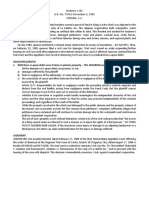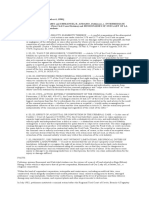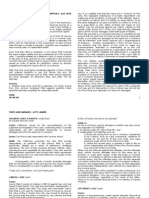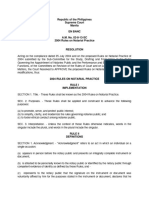Andamo Case
Andamo Case
Uploaded by
Carmela LopezCopyright:
Available Formats
Andamo Case
Andamo Case
Uploaded by
Carmela LopezOriginal Title
Copyright
Available Formats
Share this document
Did you find this document useful?
Is this content inappropriate?
Copyright:
Available Formats
Andamo Case
Andamo Case
Uploaded by
Carmela LopezCopyright:
Available Formats
[1] Andamo v.
IAC
G.R. No. 74761, November 06, 1990
Topic: Quasi-delict
FACTS:
Spouses Emmanuel and Natividad Andamo are the
owners of a parcel of land situated in Biga (Biluso) Silang,
Cavite which is adjacent to that of private respondent,
Missionaries of Our Lady of La Salette, Inc., a religious
corporation.
Within the land of respondent corporation, waterpaths and
contrivances, including an artificial lake, were constructed,
which allegedly inundated and eroded petitioners' land,
caused a young man to drown, damaged petitioners' crops
and plants, washed away costly fences, endangered the
lives of spouses and their laborers during rainy and stormy
seasons, and exposed plants and other improvements to
destruction.
Spouses Andamo filed a criminal case and after, a
separate civil action for damages against the respondent.
The trial court issued an order suspending further hearings
in the civil case until after judgment in the criminal case.
The Intermediate Appellate Court affirmed the order.
However, the spouses contend that the trial court and the
Appellate Court erred in dismissing Civil Case since it is
predicated on a quasi-delict.
ISSUE: Whether the corporation, which has built through
its agents, waterpaths, water conductors and contrivances
within its land, thereby causing inundation and damage to
an adjacent land, can be held civilly liable for damages
under Articles 2176 and 2177 of the Civil Code on quasi-
delicts such that the resulting civil case can proceed
independently of the criminal case
RULING:
Yes. The decision of the IAC is reversed and set aside
and the trial court is ordered to proceed with the civil case
independently of the criminal case.
The civil action is one under Articles 2176 and 2177 of the
Civil Code on quasi-delicts. All the elements of a quasi-
delict are present, to wit: (a) damages suffered by the
plaintiff, (b) fault or negligence of the defendant, or some
other person for whose acts he must respond; and (c) the
connection of cause and effect between the fault or
negligence of the defendant and the damages incurred by
the plaintiff.
Petitioners' complaint sufficiently alleges that petitioners
have sustained and will continue to sustain damage due to
the waterpaths and contrivances built by respondent
corporation. Indeed, the recitals of the complaint, the
alleged presence of damage to the petitioners, the act or
omission of respondent corporation supposedly
constituting fault or negligence, and the causal connection
between the act and the damage, with no pre-existing
contractual obligation between the parties make a clear
case of a quasi delict or culpa aquiliana. In Azucena vs.
Potenciano, the Court declared that in quasi-delicts, "(t)he
civil action is entirely independent of the criminal case
according to Articles 33 and 2177 of the Civil Code. There
can be no logical conclusion than this, for to subordinate
the civil action contemplated in the said articles to the
result of the criminal prosecution — whether it be
conviction or acquittal — would render meaningless the
independent character of the civil action and the clear
injunction in Article 31, that his action may proceed
independently of the criminal proceedings and regardless
of the result of the latter.
You might also like
- Software Development Partnership Agreement: Article I - Formation of The PartnershipDocument3 pagesSoftware Development Partnership Agreement: Article I - Formation of The PartnershipManeesh Kumar67% (3)
- Andamo Vs IACDocument1 pageAndamo Vs IACDanielleNo ratings yet
- Andamo vs. Iac DigestDocument3 pagesAndamo vs. Iac DigestAr LineNo ratings yet
- Andamo Vs Intermediate Appellate CourtDocument8 pagesAndamo Vs Intermediate Appellate CourtSachuzen23No ratings yet
- Andamo V IACDocument2 pagesAndamo V IACAgz MacalaladNo ratings yet
- Andamo vs. Intermediate Appellate Court, 191 SCRA 195, November 06, 1990Document1 pageAndamo vs. Intermediate Appellate Court, 191 SCRA 195, November 06, 1990Rizchelle Sampang-ManaogNo ratings yet
- Andamo V IAC DigestDocument2 pagesAndamo V IAC DigestJose Ramon Ampil100% (2)
- ANDAMO vs. IACDocument4 pagesANDAMO vs. IACJocel BatagaNo ratings yet
- Andamo vs. IacDocument1 pageAndamo vs. IacMau ReenNo ratings yet
- 189 Andamo V IACDocument12 pages189 Andamo V IACTon RiveraNo ratings yet
- Case Digests Torts No. 1Document2 pagesCase Digests Torts No. 1Tien BernabeNo ratings yet
- Andamo V IAC G.R. No. 74761 November 6, 1990 Fernan, C.J.:: FactsDocument1 pageAndamo V IAC G.R. No. 74761 November 6, 1990 Fernan, C.J.:: FactsAnonymous hS0s2mo100% (1)
- 1 Andamo Vs IACDocument2 pages1 Andamo Vs IACMelody May Omelan ArguellesNo ratings yet
- Andamano Vs IacDocument2 pagesAndamano Vs IacADNo ratings yet
- Torts and Damages: Case Digests - 2 BatchDocument16 pagesTorts and Damages: Case Digests - 2 BatchPaulo Villarin100% (1)
- Lim Vs BrownelsDocument3 pagesLim Vs BrownelsRoland Ron BantilanNo ratings yet
- Andamo v. IAC & MissionariesDocument2 pagesAndamo v. IAC & MissionariesAaron Ariston100% (2)
- Andamo V IACDocument2 pagesAndamo V IACCzar Ian AgbayaniNo ratings yet
- Andamo vs. IacDocument1 pageAndamo vs. IacZaira Gem GonzalesNo ratings yet
- Andamo Vs IACDocument3 pagesAndamo Vs IACGeenea VidalNo ratings yet
- Torts Cases - 2nd SetDocument13 pagesTorts Cases - 2nd SetJohn Steve PanchoNo ratings yet
- TORTSDocument90 pagesTORTSChloe SyGalitaNo ratings yet
- TORTSDocument90 pagesTORTSKylie GavinneNo ratings yet
- Andamo vs. IACDocument10 pagesAndamo vs. IACJesha GCNo ratings yet
- New For Civil LawDocument263 pagesNew For Civil LawReynoldMabaitLayamNo ratings yet
- Torts Full Cases - Batch 2Document44 pagesTorts Full Cases - Batch 2Mari Erika Joi BancualNo ratings yet
- Andamo Vs IACDocument6 pagesAndamo Vs IACArmen MagbitangNo ratings yet
- NIA v. IACDocument1 pageNIA v. IACKaren Joy MasapolNo ratings yet
- Andamo Vs IACDocument4 pagesAndamo Vs IACPam MiraflorNo ratings yet
- Andamo V IECDocument8 pagesAndamo V IECMarkKevinAtendidoVidar100% (1)
- NIA, Et Al v. IAC, Et AlDocument3 pagesNIA, Et Al v. IAC, Et AlTeresita LunaNo ratings yet
- Prop 12 Andamo Vs IACDocument12 pagesProp 12 Andamo Vs IACchriselskiNo ratings yet
- Torts and Damages Part 2Document144 pagesTorts and Damages Part 2ConnieAllanaMacapagaoNo ratings yet
- CD - 79. Natividad Andamo Et. Al, Vs.1acDocument1 pageCD - 79. Natividad Andamo Et. Al, Vs.1acMykaNo ratings yet
- Edgar Jarantilla V. Court of Appeals and Jose Kuan Sing (Pau) FactsDocument31 pagesEdgar Jarantilla V. Court of Appeals and Jose Kuan Sing (Pau) FactsLhine KiwalanNo ratings yet
- TortsDocument31 pagesTortsMirza Ahad BaigNo ratings yet
- Supreme Court: Lope E. Adriano For Petitioners. Padilla Law Office For Private RespondentDocument5 pagesSupreme Court: Lope E. Adriano For Petitioners. Padilla Law Office For Private RespondentCzarina UmilinNo ratings yet
- Andamo Vs IacDocument4 pagesAndamo Vs IacRaf RufNo ratings yet
- Civil Law 2 Module 1 Case #008 - Andamo vs. IAC, 191 SCRA 195Document6 pagesCivil Law 2 Module 1 Case #008 - Andamo vs. IAC, 191 SCRA 195Ronald MedinaNo ratings yet
- 19 Syquia v. Court of AppealsDocument2 pages19 Syquia v. Court of AppealsRem SerranoNo ratings yet
- National Power Corp. vs. CADocument13 pagesNational Power Corp. vs. CAChristine Gel MadrilejoNo ratings yet
- Supreme Court: Lope E. Adriano For Petitioners. Padilla Law Office For Private RespondentDocument4 pagesSupreme Court: Lope E. Adriano For Petitioners. Padilla Law Office For Private RespondentChristopher ArellanoNo ratings yet
- Torts PorrasDocument4 pagesTorts PorrasWinston AbajeroNo ratings yet
- Syquia V Ca Digested DDDDDocument1 pageSyquia V Ca Digested DDDDVincent BernardoNo ratings yet
- Napocor vs. CA, GR No. 124378, March 8, 2005 (FCD)Document2 pagesNapocor vs. CA, GR No. 124378, March 8, 2005 (FCD)Rizchelle Sampang-ManaogNo ratings yet
- 9 - (G.R. No. 74761. November 06, 1990)Document6 pages9 - (G.R. No. 74761. November 06, 1990)Lilian FloresNo ratings yet
- Lope E. Adriano For Petitioners. Padilla Law Office For Private RespondentDocument18 pagesLope E. Adriano For Petitioners. Padilla Law Office For Private RespondentKrison LaforgaNo ratings yet
- Torts DigestsDocument25 pagesTorts DigestsSS0% (1)
- PAT - 2ndDocument42 pagesPAT - 2ndMiaNo ratings yet
- Gulfo Vs AnchetaDocument3 pagesGulfo Vs Anchetamailah awingNo ratings yet
- Torts Reviewer 2EDocument112 pagesTorts Reviewer 2EMacel Ylagan DacanayNo ratings yet
- Oblicon Digests 6-8Document3 pagesOblicon Digests 6-8Jai EsNo ratings yet
- Obligations and Contracts - Article 1157 To 1174Document25 pagesObligations and Contracts - Article 1157 To 1174Miguel Alag100% (1)
- Syquia V CaDocument5 pagesSyquia V Cacacarrina_villaricaNo ratings yet
- Go and NPC TortsDocument2 pagesGo and NPC TortsJay Arnold PanganibanNo ratings yet
- Art 1773Document17 pagesArt 1773Jee CortezNo ratings yet
- 10 Andamo v. IACDocument2 pages10 Andamo v. IACAnthony ChoiNo ratings yet
- G.R. No. 175301 August 15, 2012 EDITO GULFO and EMMANUELA GULFO, Petitioners, JOSE P. ANCHETA, RespondentDocument4 pagesG.R. No. 175301 August 15, 2012 EDITO GULFO and EMMANUELA GULFO, Petitioners, JOSE P. ANCHETA, RespondentGellian eve OngNo ratings yet
- Custodio Et Al Vs Court of AppealsDocument6 pagesCustodio Et Al Vs Court of AppealsMendoza KelvinNo ratings yet
- Chain of CustodyDocument9 pagesChain of CustodyCarmela LopezNo ratings yet
- Chapter 4 EditedDocument10 pagesChapter 4 EditedCarmela LopezNo ratings yet
- Evid 3Document1 pageEvid 3Carmela LopezNo ratings yet
- Evidence 1Document1 pageEvidence 1Carmela LopezNo ratings yet
- False AdvertisingDocument33 pagesFalse AdvertisingCarmela LopezNo ratings yet
- Evidence (Law 543) Fall 2017 Handout # 5Document80 pagesEvidence (Law 543) Fall 2017 Handout # 5Carmela LopezNo ratings yet
- Answers To Guide Questions On GuardianshipDocument10 pagesAnswers To Guide Questions On GuardianshipCarmela LopezNo ratings yet
- Whereas A Much Higher Graduated Tax Rates of 5% To 60% Are Applied To Self-Employed/professionalsDocument1 pageWhereas A Much Higher Graduated Tax Rates of 5% To 60% Are Applied To Self-Employed/professionalsCarmela LopezNo ratings yet
- Case 6Document9 pagesCase 6Carmela LopezNo ratings yet
- Notarial Practice RuleDocument15 pagesNotarial Practice RuleCarmela LopezNo ratings yet
- Estarija vs. PeopleDocument1 pageEstarija vs. PeopleCarmela Lopez100% (1)
- En Banc (GR No. 93054, Dec 04, 1990) Cordillera Regional Assembly Member Alexander P. Ordillo V. ComelecDocument5 pagesEn Banc (GR No. 93054, Dec 04, 1990) Cordillera Regional Assembly Member Alexander P. Ordillo V. ComelecCarmela LopezNo ratings yet
- Swot AnalysisDocument3 pagesSwot AnalysisCarmela Lopez100% (3)
- Zoleta v. SandiganbayanDocument7 pagesZoleta v. SandiganbayanCarmela LopezNo ratings yet
- FBDC Vs YllasDocument1 pageFBDC Vs YllasCarmela LopezNo ratings yet
- Nicaragua and Lotus CaseDocument6 pagesNicaragua and Lotus CaseCarmela LopezNo ratings yet
- Nego CasesDocument44 pagesNego CasesCarmela LopezNo ratings yet
- Executive Order No. 292 (BOOK IV/Chapter 2-Secretaries, Undersecretaries, and Assistant Secretaries)Document2 pagesExecutive Order No. 292 (BOOK IV/Chapter 2-Secretaries, Undersecretaries, and Assistant Secretaries)Carmela LopezNo ratings yet
- Laras Gifts and Decors Vs Midtown Industrial SalesDocument23 pagesLaras Gifts and Decors Vs Midtown Industrial SalesFacio BoniNo ratings yet
- Cases (Full Text, Criminal Procedure X Finals)Document186 pagesCases (Full Text, Criminal Procedure X Finals)Mico James WakowkowNo ratings yet
- Intellectual Property: INFS 452 - Computer Ethics & SocietyDocument14 pagesIntellectual Property: INFS 452 - Computer Ethics & Societyفضل الفقيةNo ratings yet
- Defining Femicide - United Nations Speech by Diana E. H. Russell PH.DDocument3 pagesDefining Femicide - United Nations Speech by Diana E. H. Russell PH.DJanaína RNo ratings yet
- Con Law OutlineDocument44 pagesCon Law Outlinemsegarra88No ratings yet
- Charitable Fund Raising Ohio by Professional Solicitors ReportDocument91 pagesCharitable Fund Raising Ohio by Professional Solicitors ReportMike DeWineNo ratings yet
- 32 Freedom From Debt Coalition v. Energy Regulatory CommissionDocument5 pages32 Freedom From Debt Coalition v. Energy Regulatory CommissionArnel ManalastasNo ratings yet
- IB FormDocument2 pagesIB FormMirza Asjad RazaNo ratings yet
- This Study Resource WasDocument5 pagesThis Study Resource WasRUCHI KUMARI 195No ratings yet
- Trading TermsDocument9 pagesTrading Termsr4ndom1zedNo ratings yet
- Briefing: Dispute ResolutionDocument3 pagesBriefing: Dispute ResolutionFavour StormNo ratings yet
- Whose Hand Should Rock The Cradle? Recognizing The Right of The Mother and The Biological Father To Impugn The Legitimacy of A ChildDocument18 pagesWhose Hand Should Rock The Cradle? Recognizing The Right of The Mother and The Biological Father To Impugn The Legitimacy of A Childgiovanni bastasaNo ratings yet
- Reyes Vs HRET GR 221103Document20 pagesReyes Vs HRET GR 221103Di JoyaNo ratings yet
- Wildlife Protection Act Environment Protection Act Forest Conservation ActDocument12 pagesWildlife Protection Act Environment Protection Act Forest Conservation ActSaurabh DeyNo ratings yet
- Taxable Person Under GST: Find GST Rate, HSN Code & Sac CodeDocument2 pagesTaxable Person Under GST: Find GST Rate, HSN Code & Sac CodeAnonymous uHT7dDNo ratings yet
- Local Govt TaxDocument18 pagesLocal Govt TaxJermaine SemañaNo ratings yet
- PNB vs. Hydro Resources 11Document14 pagesPNB vs. Hydro Resources 11kelbingeNo ratings yet
- United States District Court Middle District of Florida Tampa DivisionDocument7 pagesUnited States District Court Middle District of Florida Tampa Divisionnolu chanNo ratings yet
- Advisory No. 028 S, 2022-Submission of Bir Form No. 2316 To The Bureau of Internal Revenue - Revenue District Office No. 2Document2 pagesAdvisory No. 028 S, 2022-Submission of Bir Form No. 2316 To The Bureau of Internal Revenue - Revenue District Office No. 2Yoregeff DaiunNo ratings yet
- 9-23-15 DOJ Letter On Ahmed MohamedDocument3 pages9-23-15 DOJ Letter On Ahmed MohamedMike HondaNo ratings yet
- Deloitte Partner Steven Klig Busted For Sex ExtortionDocument34 pagesDeloitte Partner Steven Klig Busted For Sex ExtortionDeloitte LawsuitNo ratings yet
- Statement of Objections For I.A No.6 Prasanna v. MadhavaDocument3 pagesStatement of Objections For I.A No.6 Prasanna v. MadhavaSharath Kanzal100% (1)
- Cybercrimelawinthephilippines 121018145839 Phpapp02Document13 pagesCybercrimelawinthephilippines 121018145839 Phpapp02MARIA PAMELA SURBANNo ratings yet
- Carrie Mars v. Spartanburg Chrysler Plymouth, Inc. and First National Bank of South Carolina, 713 F.2d 65, 1st Cir. (1983)Document4 pagesCarrie Mars v. Spartanburg Chrysler Plymouth, Inc. and First National Bank of South Carolina, 713 F.2d 65, 1st Cir. (1983)Scribd Government DocsNo ratings yet
- Arciga Vs ManiwangDocument3 pagesArciga Vs ManiwangAndree MorañaNo ratings yet
- Knecht Vs CA Case DigestDocument2 pagesKnecht Vs CA Case DigestmenforeverNo ratings yet
- 14.08.2023 Competition Questions No.1 ENDocument3 pages14.08.2023 Competition Questions No.1 EN23515015No ratings yet
- Booking CardDocument1 pageBooking Cardapi-25900774No ratings yet
- CAA Micro-ProjectDocument13 pagesCAA Micro-ProjectAkanksha GopalkarNo ratings yet
- StemGenex Lawsuit Document 134 Judge's Order Granting Plaintiff's Motion For Class CertificationDocument17 pagesStemGenex Lawsuit Document 134 Judge's Order Granting Plaintiff's Motion For Class CertificationLeighTurnerNo ratings yet












































































































